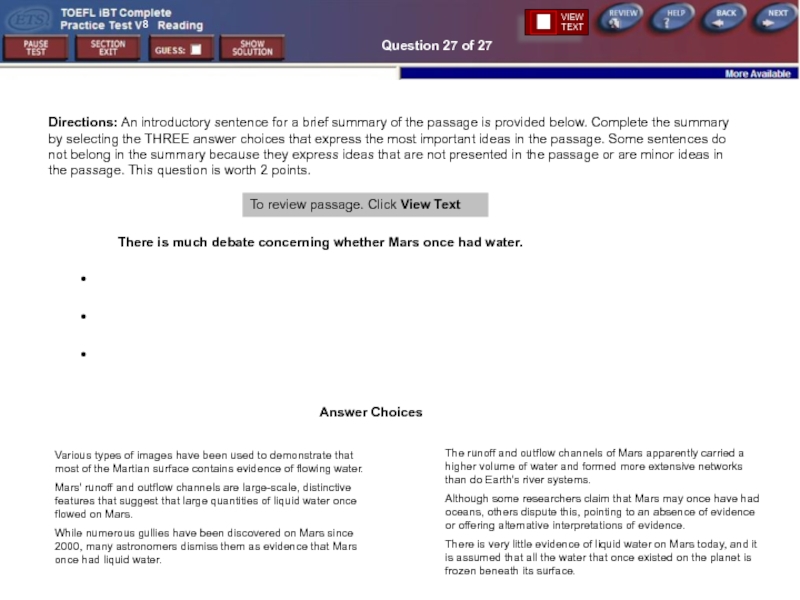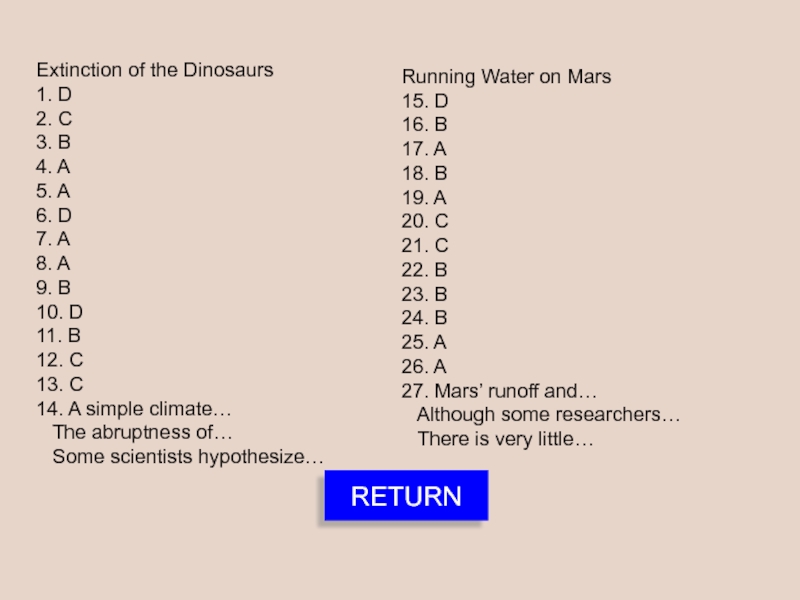- Главная
- Разное
- Дизайн
- Бизнес и предпринимательство
- Аналитика
- Образование
- Развлечения
- Красота и здоровье
- Финансы
- Государство
- Путешествия
- Спорт
- Недвижимость
- Армия
- Графика
- Культурология
- Еда и кулинария
- Лингвистика
- Английский язык
- Астрономия
- Алгебра
- Биология
- География
- Детские презентации
- Информатика
- История
- Литература
- Маркетинг
- Математика
- Медицина
- Менеджмент
- Музыка
- МХК
- Немецкий язык
- ОБЖ
- Обществознание
- Окружающий мир
- Педагогика
- Русский язык
- Технология
- Физика
- Философия
- Химия
- Шаблоны, картинки для презентаций
- Экология
- Экономика
- Юриспруденция
Test TPO 8. Extinction of the dinosaurs. (Section 2) презентация
Содержание
- 1. Test TPO 8. Extinction of the dinosaurs. (Section 2)
- 3. Question 1 of 27
- 4. Question 2 of
- 5. Question 3
- 6. Question 4
- 7. Question 5
- 8. Question 6
- 9. Question 7
- 10. Question 8
- 11. Question 9
- 12. Question 10
- 13. Question 11
- 14. Question 12
- 15. Look at the four squares
- 16. Question 14
- 19. The word
- 20. What does
- 21. The
- 22. The
- 23. In
- 24. According
- 25. All
- 26. According
- 27. Which
- 28. According
- 29. The
- 30. Look at the four squares
- 31. Question 27
- 33. Congratulations! You have completed this practice test.
- 34. RETURN Extinction of the Dinosaurs 1. D
- 35. Are you sure you want to exit
- 36. Your answers will be saved with the
- 37. OK When your computer asks you if
- 38. OK When your computer asks you if
Слайд 3
Question 1 of 27
According to paragraph 1, which of the following
Summers were very warm and winters were very cold
Shallow seas on the continents caused frequent temperature changes
The climate was very similar to today's climate
The climate did not change dramatically from season to season.
Paragraph 1 is marked with ◆
Слайд 4
Question 2 of 27
Which of the following reasons is suggested in
Changes in the lengths of the days and nights during the Late Cretaceous period
Droughts caused by the movement of seaways back into the oceans
The change from mild to severe climates during the Late Cretaceous period
An extreme decrease in the average yearly temperature over 10,000 years
Paragraph 2 is marked with ◆
Слайд 5
Question 3 of 27
To argue that dinosaurs may have become extinct
To question the adequacy of the hypothesis that climatic change related to sea levels caused the extinction of the dinosaurs
To present examples of animals that could maintain a livable body temperature more easily than dinosaurs
To support a hypothesis that these animals were not as sensitive to climate changes in the Cretaceous period as they are today
Why does the author mention the survival of 【snakes, lizards, turtles, and crocodiles】 in paragraph 3?
Слайд 6
Question 4 of 27
adapt
move
continue
compete
The word 【cope】 in the
Слайд 7
Question 5 of 27
According to paragraph 3, which of the following
Climate changes associated with the movement of seaways before the Cretaceous period did not cause dinosaurs to become extinct.
Changes in climate before the Cretaceous period caused severe fluctuations in sea level, resulting in the extinction of the dinosaurs.
Frequent changes in climate before the Cretaceous period made dinosaurs better able to maintain a livable body temperature.
Before the Cretaceous period there were few changes in climate, and dinosaurs flourished
Paragraph 3 is marked with ◆
Слайд 8
Question 6 of 27
extremes
retreats
periods
variations
The word 【fluctuations】 in the
Слайд 9
Question 7 of 27
Which of the sentences below best expresses the
The fossil record suggests that there was an abrupt extinction of many plants and animals at the end of the Mesozoic era
Few fossils of the Mesozoic era have survived in the rocks that mark the end of the Cretaceous.
Fossils from the Cretaceous period of the Mesozoic up to the beginning of the Cenozoic era have been removed from the layers of rock that surrounded them.
Plants and animals from the Mesozoic era were unable to survive in the Cenozoic era.
Слайд 10
Question 8 of 27
In paragraph 4, all the following questions are
Why is there a layer of clay between the rocks of the Cretaceous and Cenozoic?
Why were scientists interested in determining how long it took to deposit the layer of clay at the end of the Cretaceous?
What was the effect of the surprising observation scientists made?
Why did scientists want more information about the dinosaur extinctions at the end of the Cretaceous?
Paragraph 4 is marked with ◆
Слайд 11
Question 9 of 27
The word 【bombard】 in the passage is closest
approach
strike
pass
circle
Слайд 12
Question 10 of 27
Paragraph 5 implies that a special explanation of
the Ir in microscopic meteorites reaching Earth during the Cretaceous period would have been incorporated into Earths core
the Ir in the boundary clay was deposited much more than a million years ago
the concentration of Ir in the boundary clay is higher than in microscopic meteorites
the amount of Ir in the boundary clay is too great to have come from microscopic meteorites during the time the boundary clay was deposited
Paragraph 5 is marked with ◆
Слайд 13
Question 11 of 27
The word 【disruption】 in the passage is closest
exhaustion
disturbance
modification
disappearance
Слайд 14
Question 12 of 27
Paragraph 6 mentions all of the following effects
a large dust cloud that blocked sunlight
an immediate drop in the surface temperatures of the continents
an extreme decrease in rainfall on the continents
a long-term increase in global temperatures
Paragraph 6 are marked with ◆
Слайд 15
Look at the four squares [■]that indicate where the following sentence
Consequently, the idea that the Ir in the boundary clay came from microscopic meteorites cannot be accepted.
Where would the sentence best fit?
■ 1
■ 2
■ 3
■ 4
Question 13 of 27
Слайд 16
Question 14 of 27
Directions: An introductory sentence for a brief summary
Answer Choices
To review passage. Click View Text
For a long time scientists have argued that the extinction of the dinosaurs was related to climate change.
●
●
●
Extreme changes in daily and seasonal climates preceded the retreat of the seas back into the major ocean basins.
The retreat of the seaways at the end of the Cretaceous has not been fully explained.
Some scientists hypothesize that the extinction of the dinosaurs resulted from the effects of an asteroid collision with Earth.
A simple climate change does not explain some important data related to the extinction of the dinosaurs at the end of the Cretaceous.
The abruptness of extinctions at the end of the Cretaceous and the high concentration of Ir found in clay deposited at that time have fueled the development of a new hypothesis.
Boundary clay layers like the one between the Mesozoic and Cenozoic are used by scientists to determine the rate at which an extinct species declined.
Слайд 19
The word 【merge】 in the passage is closest in meaning to
expand
separate
straighten out
combine
Question 15 of 27
Слайд 20
What does the discussion in paragraph 1 of runoff channels in
The atmosphere of Mars was once thinner than it is today.
Large amounts of rain once fell on parts of Mars.
The river systems of Mars were once more extensive than Earth's.
The rivers of Mars began to dry up about 4 billion years ago.
Paragraph 1 is marked with ◆
Question 16 of 27
Слайд 21
The word 【relics】 in the passage is closest in meaning to
remains
sites
requirements
sources
Question 17 of 27
Слайд 22
The word 【miniature】 in the passage is closest in meaning to
temporary
small
multiple
familiar
Question
Слайд 23
In paragraph 2, why does the author include the information that
To emphasize the great size of the volume of water that seems to have flowed through Mars" outflow channels
To indicate data used by scientists to estimate how long ago Mars' outflow channels were formed
To argue that flash floods on Mars may have been powerful enough to cause tear-shaped "islands" to form
To argue that the force of flood waters on Mars was powerful enough to shape the northern volcanic plains
Paragraph 2 is marked with ◆
Question 19 of 27
Слайд 24
According to paragraph 2, all of the following are true of
They formed at around the same time that volcanic activity was occurring on the northern plains.
They are found only on certain parts of the Martian surface.
They sometimes empty onto what appear to have once been the wet sands of tidal beaches.
They are thought to have carried water northward from the equatorial regions.
Paragraph 2 is marked with ◆
Question 20 of 27
Слайд 25
All of the following questions about geological features on Mars are
What are some regions of Mars that may have once been covered with an ocean?
Where do mission scientists believe that the river forming the delta emptied?
Approximately how many craters on Mars do mission scientists believe may once have been lakes filled with water?
During what period of Mars' history do some scientists think it may have had large bodies of water?
Paragraph 2 is marked with ◆
Question 21 of 27
Слайд 26
According to paragraph 3, images of Mars surface have been interpreted
the polar regions of Mars were once more extensive than they are now
a large part of the northern lowlands may once have been under water
deltas were once a common feature of the Martian landscape
the shape of the Hellas Basin has changed considerably over time
Paragraph 3 is marked with ◆
Question 22 of 27
Слайд 27
Which of the sentences below best expresses the essential information in
But detractors argue that geological activity may be responsible for the water associated with the terraces.
But detractors argue that the terraces may have been formed by geological activity rather than by the presence of water.
But detractors argue that the terraces may be related to geological forces in the Northern Hemisphere of Mars, rather than to Martian water in the south.
But detractors argue that geological forces depressed the Northern Hemisphere so far below the level of the south that the terraces could not have been formed by water.
Question 23 of 27
Слайд 28
According to paragraph 4, what do the 2003 Global Surveyor data
Ancient oceans on Mars contained only small amounts of carbon.
The climate of Mars may not have been suitable for the formation of large bodies of water.
Liquid water may have existed on some parts of Mars' surface for long periods of time
The ancient oceans that formed on Mars dried up during periods of cold, dry weather.
Paragraph 4 is marked with ◆
Question 24 of 27
Слайд 29
The word 【hints】 in the passage is closest in meaning to
clues
features
arguments
effects
Question 25 of 27
Слайд 30
Look at the four squares [■]that indicate where the following sentence
These landscape features differ from runoff channels in a number of ways.
Where would the sentence best fit?
■ 1
■ 2
■ 3
■ 4
Question 26 of 27
Слайд 31
Question 27 of 27
Directions: An introductory sentence for a brief summary
To review passage. Click View Text
There is much debate concerning whether Mars once had water.
●
●
●
Answer Choices
Various types of images have been used to demonstrate that most of the Martian surface contains evidence of flowing water.
Mars' runoff and outflow channels are large-scale, distinctive features that suggest that large quantities of liquid water once flowed on Mars.
While numerous gullies have been discovered on Mars since 2000, many astronomers dismiss them as evidence that Mars once had liquid water.
The runoff and outflow channels of Mars apparently carried a higher volume of water and formed more extensive networks than do Earth's river systems.
Although some researchers claim that Mars may once have had oceans, others dispute this, pointing to an absence of evidence or offering alternative interpretations of evidence.
There is very little evidence of liquid water on Mars today, and it is assumed that all the water that once existed on the planet is frozen beneath its surface.
Слайд 33Congratulations!
You have completed this practice test.
Save / exit the test
Review
Obtain answer keys
Слайд 34RETURN
Extinction of the Dinosaurs
1. D
2. C
3. B
4. A
5. A
6. D
7. A
8.
9. B
10. D
11. B
12. C
13. C
14. A simple climate…
The abruptness of…
Some scientists hypothesize…
Running Water on Mars
15. D
16. B
17. A
18. B
19. A
20. C
21. C
22. B
23. B
24. B
25. A
26. A
27. Mars’ runoff and…
Although some researchers…
There is very little…
Слайд 35Are you sure you want to exit the test?
YES
NO
Exit the test.
Return to the last question and resume doing the test.
Слайд 36Your answers will be saved with the file.
Your answers will
Do you want to save your answers?
YES
NO


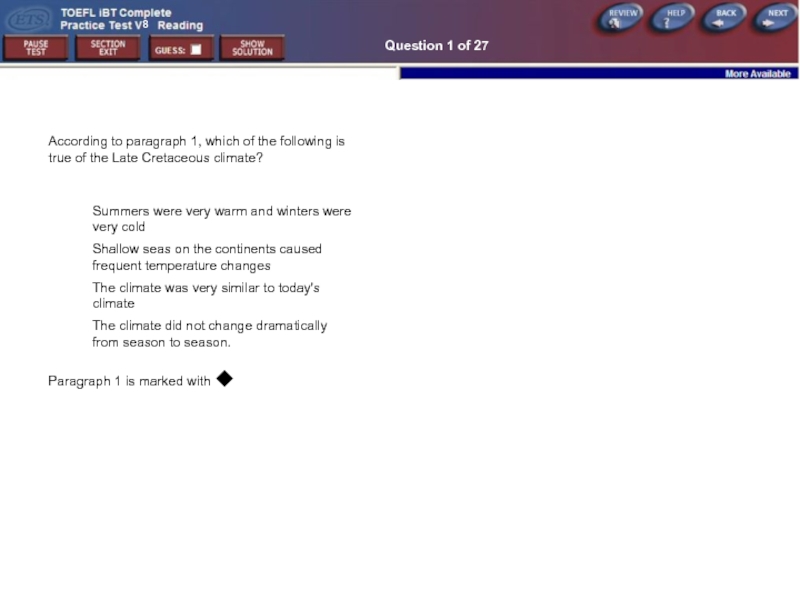
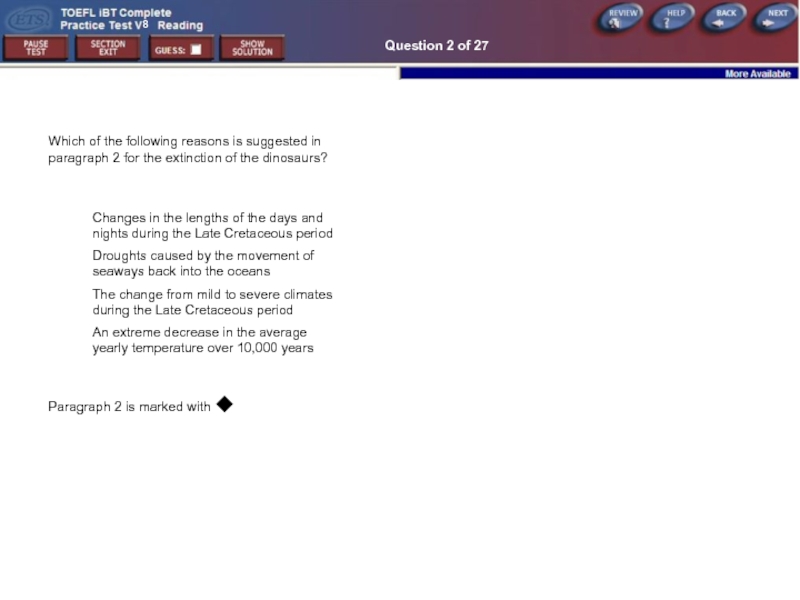


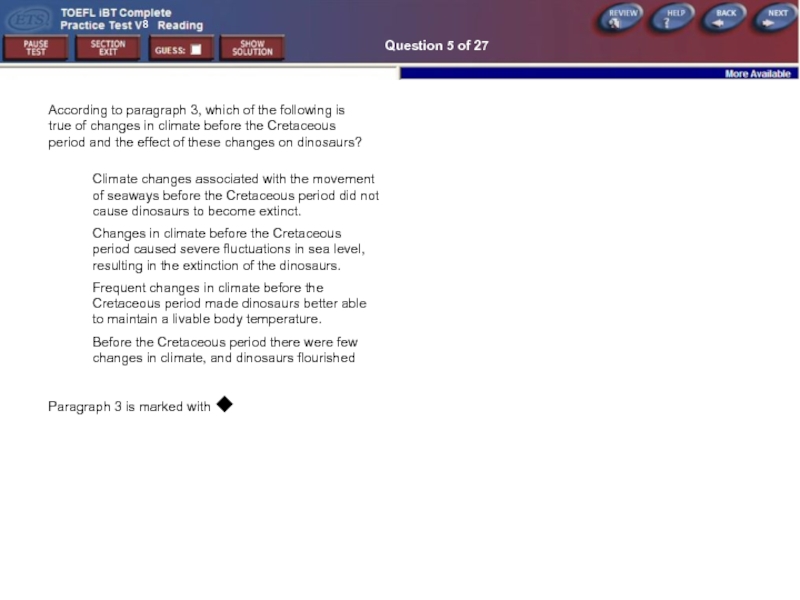

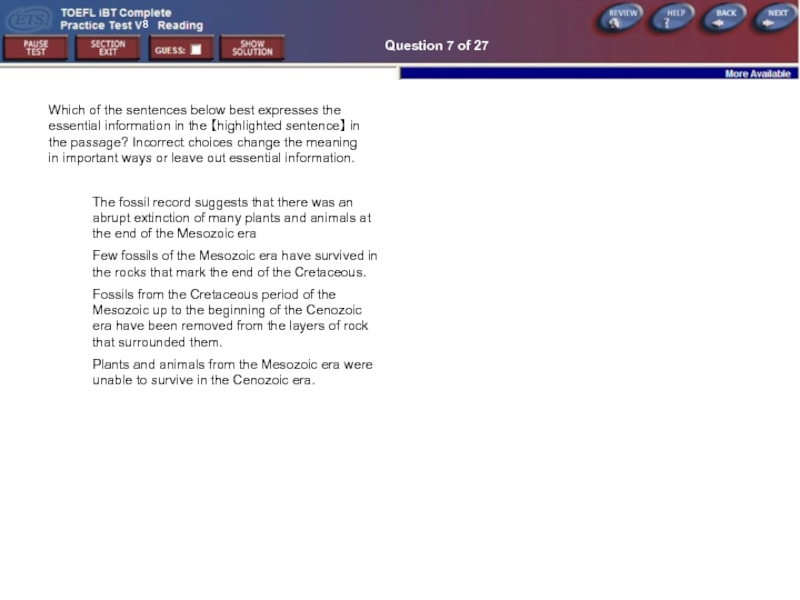
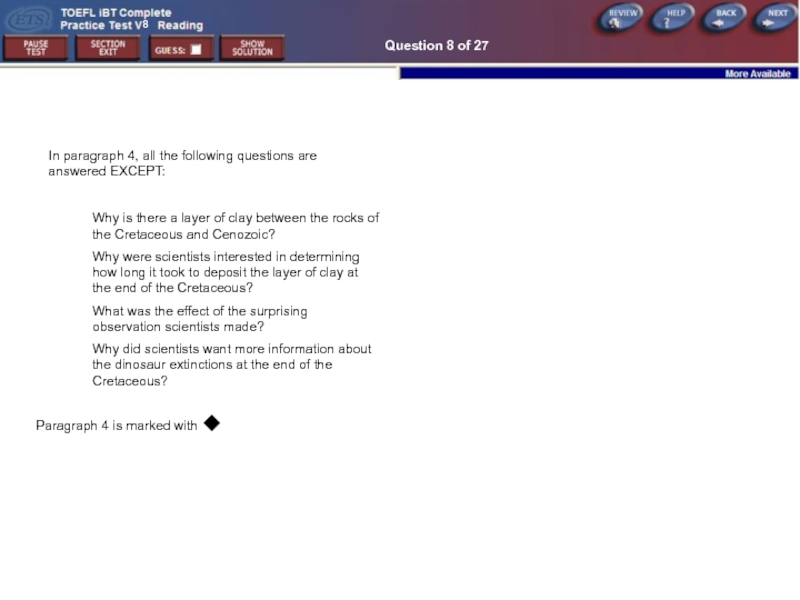

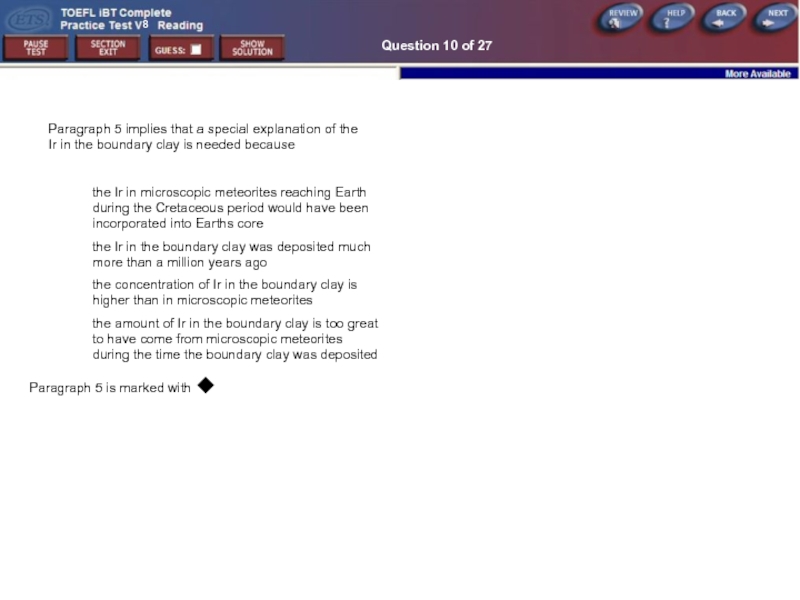

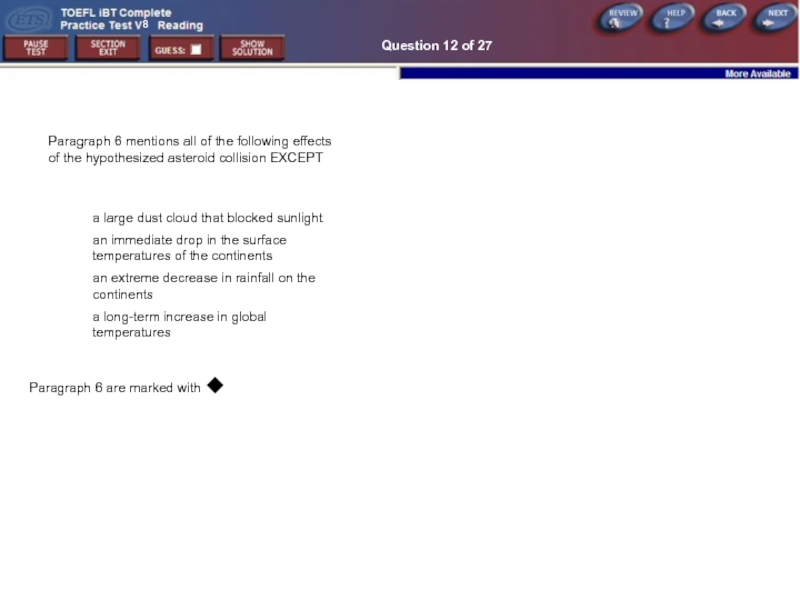
![Look at the four squares [■]that indicate where the following sentence could be added to](/img/tmb/5/413601/c81523ba7daf95ccb02206dcecf20302-800x.jpg)
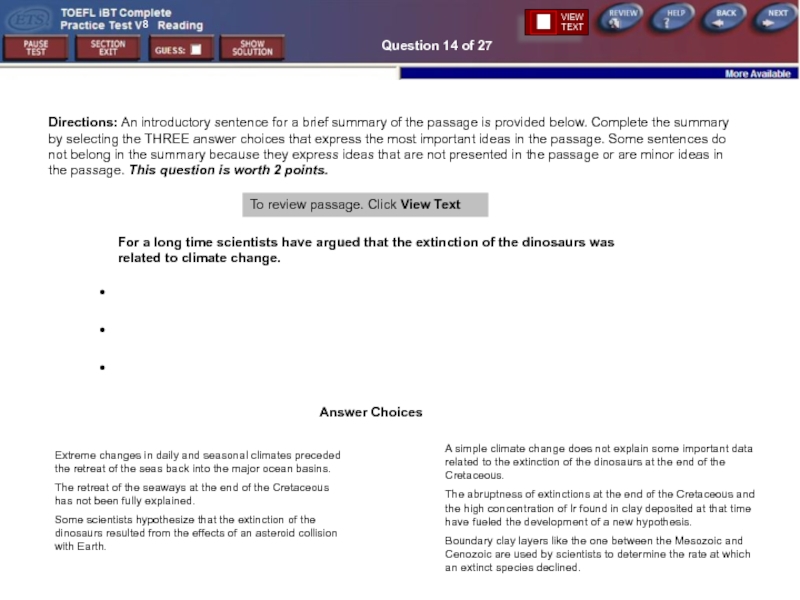



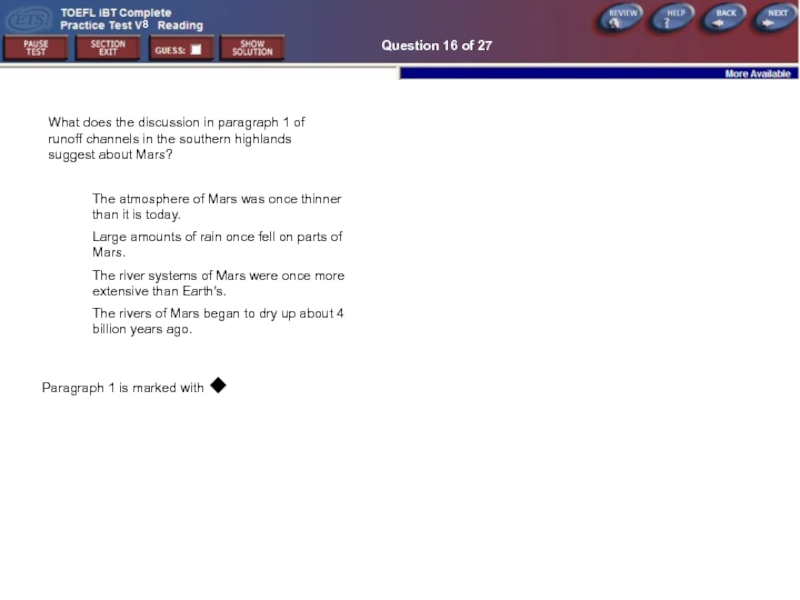



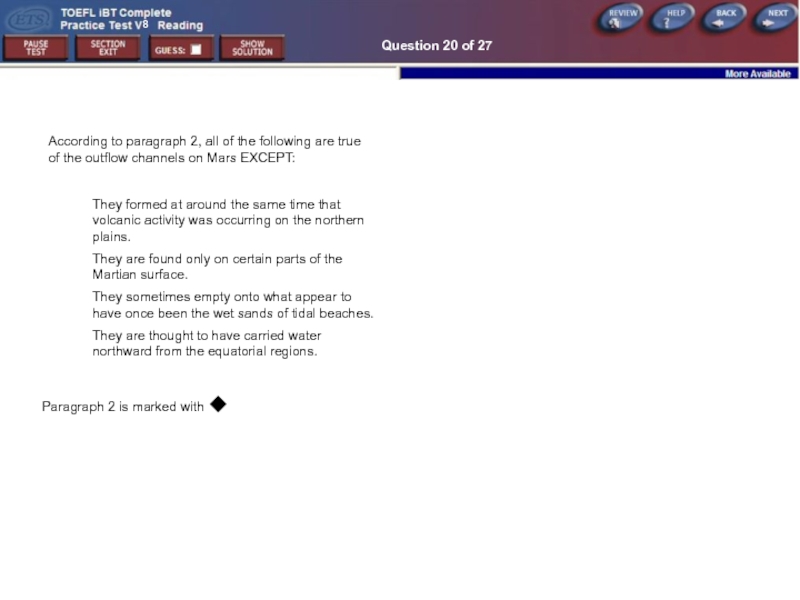
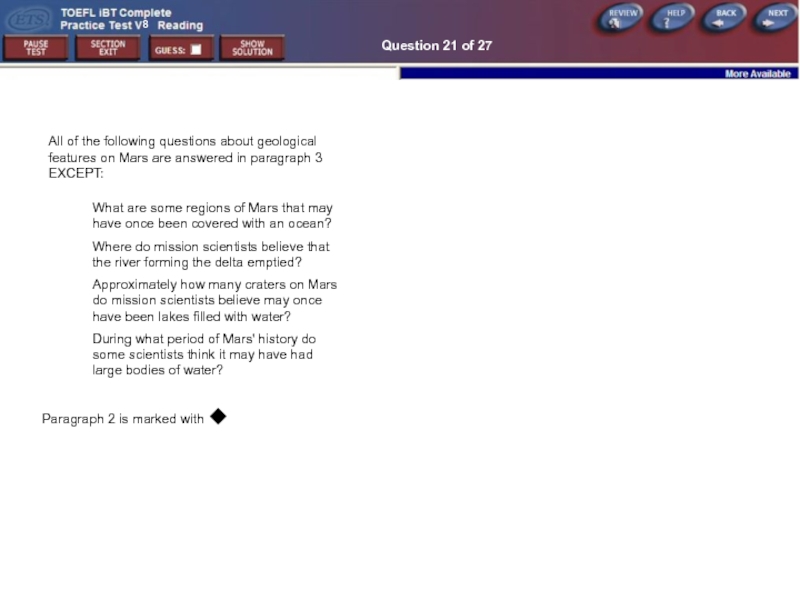
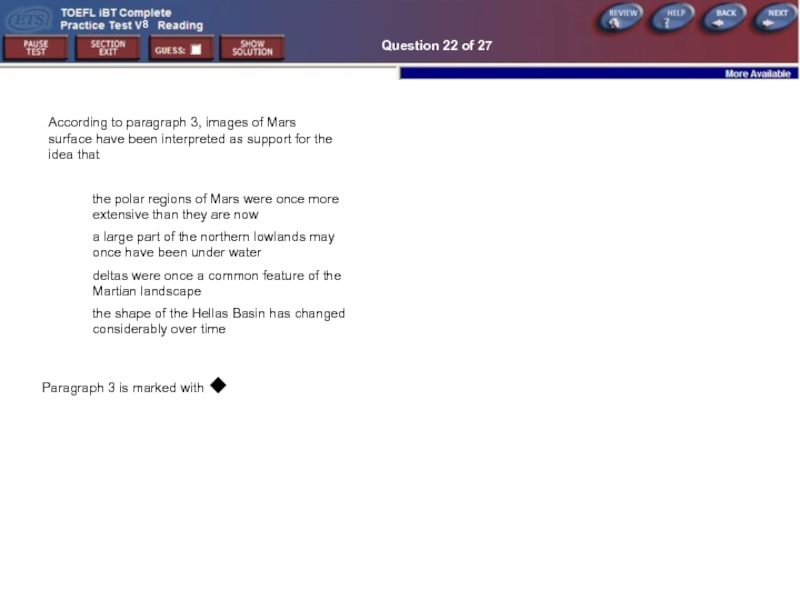
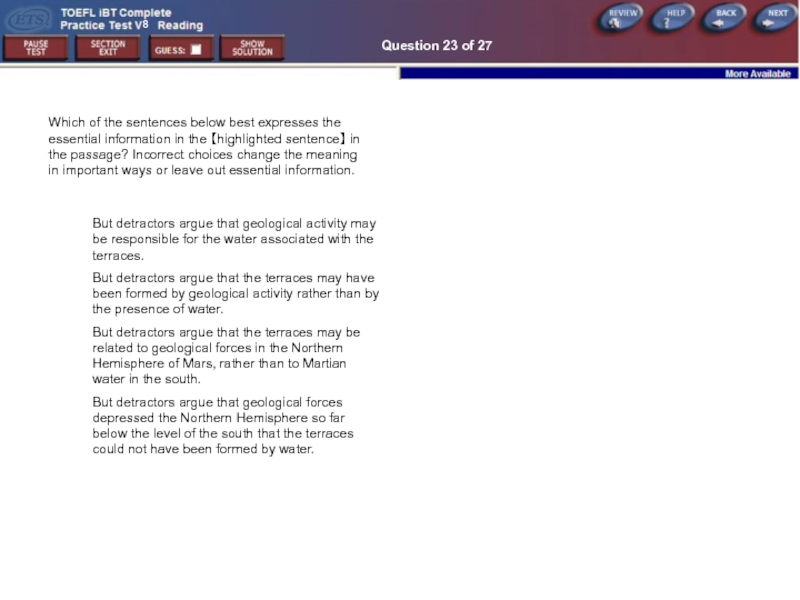
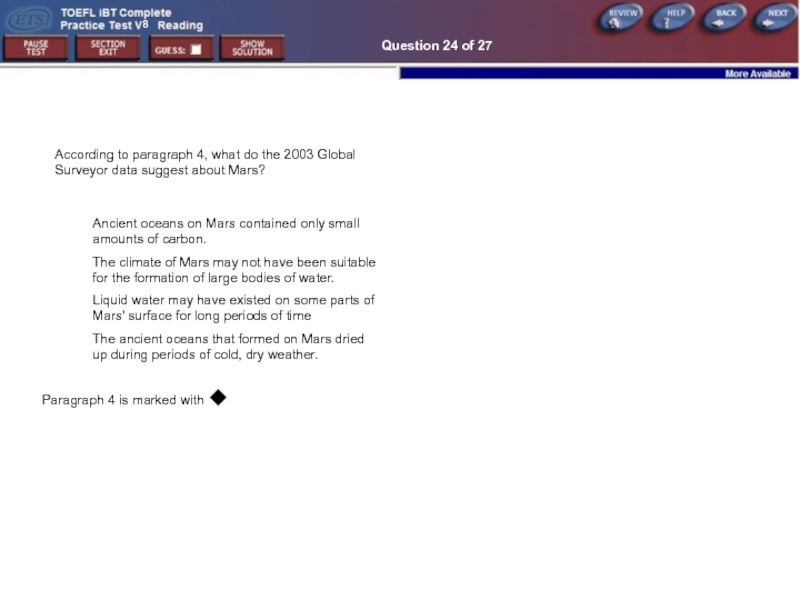

![Look at the four squares [■]that indicate where the following sentence could be added to](/img/tmb/5/413601/0bf87e8045c3e99bc75c49eb3762290b-800x.jpg)
